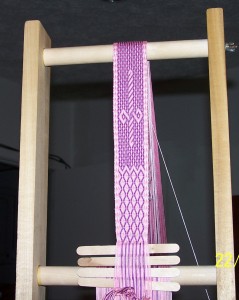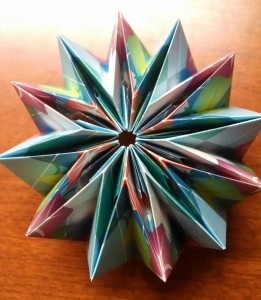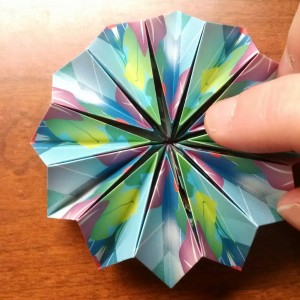I tend to spend a lot of time fiddling out new patterns, most often for tablet weaving, but also for brickstitch and occasionally blackwork. In fact, I’ve got blackwork on the brain at the moment after Kim Salazar posted Blackwork Inspiration, an article in which she talks about places to find inspiration.
I realized as I was reading her article that I like designing patterns in tightly constrained spaces. In tabletweaving, especially when designing patterns designed to be warped up quickly using speed warping, the design is primarily affected by how the tablets turn. You have essentially three options here; a tablet can turn forwards, backwards, or it can stay idle. I haven’t really started experimenting with tablet idling yet, so that reduces it to two turns, which can easily be plenty.
 Consider for instance an early pattern I called Daggers. Back when I was graphing this I was using shorthand; each square represents two tablets and two quarter turns. The colour of the thread is actually indicated by whether the line is solid (colour 1) or dashed (colour 2), and the background colour (colour 3) isn’t shown at all; forward turns are blue and backwards turns are red.
Consider for instance an early pattern I called Daggers. Back when I was graphing this I was using shorthand; each square represents two tablets and two quarter turns. The colour of the thread is actually indicated by whether the line is solid (colour 1) or dashed (colour 2), and the background colour (colour 3) isn’t shown at all; forward turns are blue and backwards turns are red.
The tablets are warped so that each tablet has, in clockwise direction, colours 1 – 3 – 2 – 3 (although often when I wove it, the background colour and the second colour where the same colour, making the warping 1 – 2 – 2 – 2). This allows for quick speed warping using the continuous warp method Linda Hendrickson describes in her description of a Continuous Warp (Linda Hendrickson). After the tablets are all warped, they are set up so that all the cards are threaded in the same direction, and then turned so that colour 1 is – moving from left to right – in the top front hole, top back, bottom back, bottom front, and repeat. Turning all the cards forward should result in straight diagonals moving to the left. If the diagonals are jagged, either flip all the cards vertically and reset, or turn every second card two quarter turns. This is all very similar to setting up for Egyptian Diagonals, except that the tablets are not all threaded two dark, two light.
 In this version, which is a slightly different pattern where the handle is longer and the guards are much bigger and the background is made with solid coloured diamonds, I was weaving a pink belt; hence the background colour is pink, colour 1 is purple, and colour 2 is white. And I just noticed I’d left out the dashed lines inside the daggers, so will leave those as an exercise for the reader.
In this version, which is a slightly different pattern where the handle is longer and the guards are much bigger and the background is made with solid coloured diamonds, I was weaving a pink belt; hence the background colour is pink, colour 1 is purple, and colour 2 is white. And I just noticed I’d left out the dashed lines inside the daggers, so will leave those as an exercise for the reader.
Patterns like this are easy to develop on grid paper; the basic rule for me is to draw out colour 1 first with the following constraints: if the diagonal changes direction, there can be no gap and for the two cards we must go from one diagonal straight to the other. If the diagonal does not change direction, then there must be a (temporarily) blank square between them. I can test the design by adding the dotted lines using the same rule. If there are two parallel diagonal lines there must be a dotted line between them. And the backgrounds I usually use either the dotted diamonds, or solid diamonds that are properly offset from the main pattern (so that there is room for the dashed lines in between).
Over time I’ve started developing diagrams that use the background (white or gray) to indicate the direction of the turn, and show every thread rather than just the dominant colours, but I find that when I’m just doodling patterns this method suits me just fine.




